

| This area of this site shows anything that is animal related. Anything from my animal pets to wildlife, including alligators in the Florida Everglades! Check out the wildlife such as birds and reptiles as well as my pet dog on this page. Note - This page may take a while to load on some SLOWER connections! |
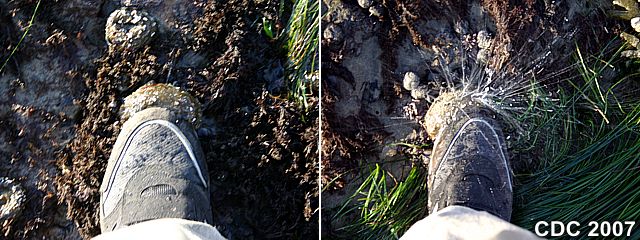
 Video Clips Coming Soon!
Video Clips Coming Soon!
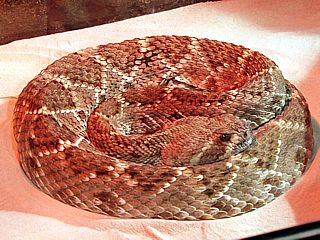
|
Western diamondback rattlesnake on display at the Big Texan restaurant and tourist center in Amarillo, Texas. |
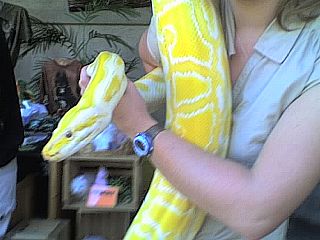
|
This is a nice picture of an albino python being handled by a snake handler during a reptile demonstration at the Six Flags theme park near Gurnee, Illinois. Note the pink color of the eyes and light creme and light yellow colored skin pigments of this magnificant albino snake specimen. |
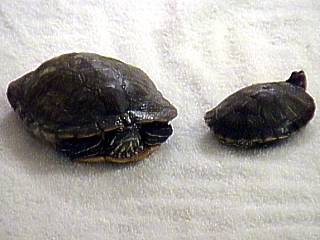
|
This is a picture of my two turtle pets. These are painted turtles, the same sold by pet suppliers for educational purposes. They are sold when they are only about the size of a quarter, but grow to adults over 6 inches long in a few years. The turtle on the left is fully grown, with a shell about 6 inches in length and 4 inches wide. The smaller one, adopted by a friend, is a little over half the size of the big one. Both turtles "live" in a special turtle pond I designed and built in my front yard. The large turtle has its arms, legs, and head retracted. The small one only has his head partially extended. |
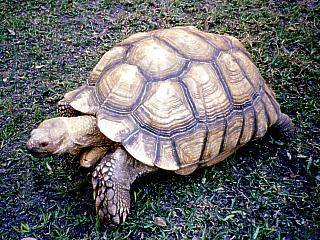
|
Here is a picture of one of two large tortouises on display at the Seminole Indian Reservation in the Florida Everglades. This one is about two feet across and roughly 10 years old. These very large turtles can live to about 100 years. |
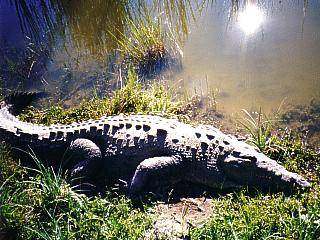
|
Here is a picture of a crocodile, not an alligator, sunning itself on the bank of a canal in the Florida Everglades. There is a difference between an alligator and a crocodile ... Can you see it in this picture? Well, it's rather simple. A crocodile has its lower set of teeth visible when its mouth is closed. In this picture, you can see that the lower teeth are showing. This crocodile is about 6 feet in length. Crocodiles (and alligators) are both reptiles and are cold-blooded, and the only way of regulating body temperature is by moving in and out of cold and warm places. The scales on the back actually collect heat from the sun therefore are natural solar panels. |
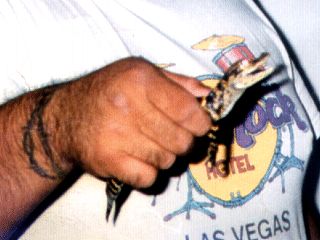
|
A newly born alligator hatchling is small enough to be safely held. This one will grow to a few feet in the first year and may live long enough to reach ten to fifteen feet. At birth, the temperature of the clutch of eggs determines the sex of the hatchlings. Note the size of the hatchling compared to the man's hand holding it. |
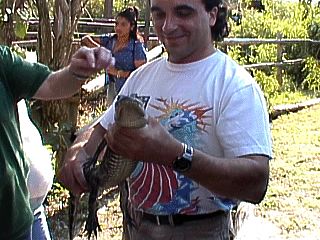
|
A young alligator, between one and two feet long, is held by myself at the Miccocukee Indian Reservation in the Florida Everglades. The Miccosukee tribe of Indians, living for over a century in this region, adapted well to the swampy environment and often wrestle these beasts as a pastime. |
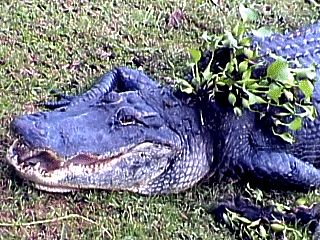
|
A large American alligator rests on an embankment in the Florida Everglades at a Miccosukee Indian camp deep in the Florida Everglades. The large gator pictured here just crawled out of the swamp and is sporting a "crown" of water hyacinths while we walk just a few feet away. |
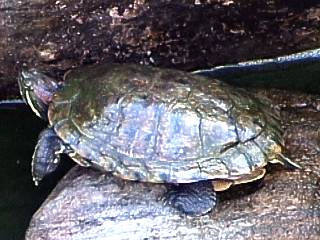
|
Here is a picture of a large painted turtle resting on a floating lava rock in my custom-built turtle pond. I reared this turtle in a fresh water tank back in 1997, feeding it freeze-dried food, where it was only the size of a quarter at that time. In 1998, he was as big as a lemon, and began eating small fish, in fact, any fish I put in the fresh water tank! In 1999, he was as big as a fist, and was kept in a larger fresh water tank with a small fountain / resting platform I built. At that time his apetite was vorcious, I even dropped small frogs and large goldfish in the tank, and he would devour them! Finally in 2000, I built this turtle pond and he has been kept there eversince. He is now fully grown, about the size of a honey-dew melon (6 inches+). He has adopted a new diet of Koi food, that's right, I feed him fish food and he loves it ... Cheap too. There were originally two of these, one slightly smaller. The smaller one mysteriously vanished from this turtle pond in early 2001 (Kids, maybe)? I adopted a smaller one, not shown here, from a friend as a replacement. |
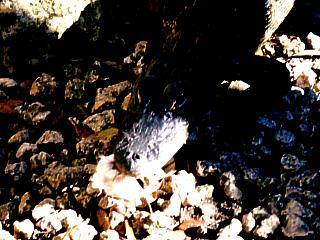
|
This picture was taken at a small alligator cage in the Billie Seminole swamp tours area in the Seminole Indian Reservation in the Florida Everglades. Small white mice were running about when one tourist picked it up by its tail and tossed it into the gator pen containing about 4 juvenile alligators (2 to 3 feet). Within seconds, one snatched the mouse for a quick snack, and allowed me to take this picture. |
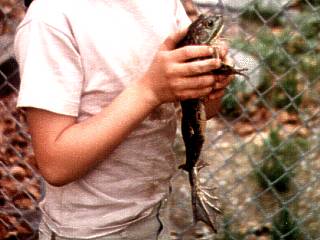
|
This is a North American Bullfrog. This is the largest frog in the western hemisphere, second to the Goliath Frog of West Africa. The specimen here is slightly less than fully grown and measures about a foot and a half in length from head to the end of the feet. Two feet, or more, is very common for such frogs. Note the extensive webbing in the feet of the bullfrog. That is myself in the picture, in 1979, still a child, holding the frog just after catching it in a pond in New York. |
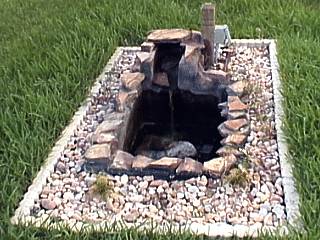
|
This is a small turtle pond I built in the front yard of my home in Miramar, Florida. This is a completely self-contained pond with electricity and water hookups. The unit was constructed with concrete half-width cinder blocks forming the floor, sides, and waterfall supports. The block forms were then covered with thick wire mesh and covered with a few inches of hydraulic fast-setting cement. The coated surface was convered with several coats of Drylock masonry water seal after the rocks were cemented to the structure also using fast-setting cement. The unit was then spray-painted with brown and black water-proof paints to match the color of the rocks. A small pump is connected to a pipe built into the unit for the waterfall as well as easy draining via a "T" and valve. The wooden post supports a waterproof outlet which is connected to the main power of the house via an underground wire conduit. An underground pipe also runs from the water spigot to another valve and "T" connector by the turtle pond to allow easy filling of the unit. A stone brick perimeter and garden rocks completes this project. A floating lava rock gives the turtle(s) a place to rest (note the turtle doing just so). You can also put fish such as Koi in this pond. Unfortunately, this installation was forced to be removed through the fine comittee of my homeowners association in June 2002. |
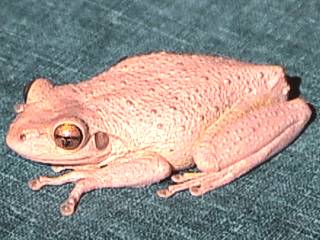
|
Here is a picture of an invasive tree frog species found in South Florida. This is the Cuban tree frog (Osteopilus Septentrionalis). The frog is often mistaken as an albino toad for two reasons, first it is mistaken for a toad because of the bumps (warts) on its skin. Secondly, this species normally has pale yellow skin, making it look like an albino (a mutation where skin lacks pigmentation). True albino creatures have pink eyes, in this picture, the eyes appear normal. This tree frog has sticky pads on its feet and strong hind legs. This frog also secrets a weak toxin from glands in its skin, unlike from parotid glands behind its ears as with a toad. |
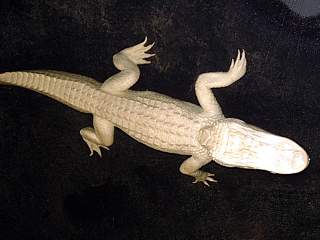
|
This is a picture, taken in Saint Augustine, Florida, of an albino american alligator. Similar to the albino tree toad shown in the picture above, this reptile also lacks pigmentation causing the skin to be cream-colored instead of dark green. |
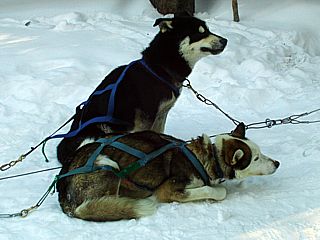
|
Here is a picture of two Siberian Husky dogs that were part of a dog-sled pulling pack near Breckenridge, Colorado. These dogs are well adapted to cold climate and noted for their agressive pulling. They are also referred to as "snow dogs" in slang terms. |
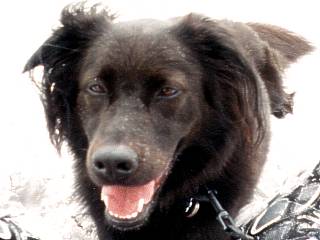
|
This is a picture of my dog named "Tito" at about 2 years old. Here he is fully grown and weighs about 45 pounds. This dog is a mixture of German Sheppard and Black Chow. This dog is a medium sized and moderately agressive dog, however, he has never laid a paw or a tooth on anyone. |
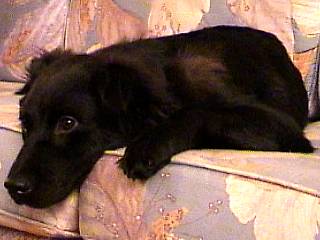
|
This is a picture of my dog named "Tito" at about 5 months old. The puppy here weighs about 20 pounds and is a mixture of German Sheppard and Black Chow. This dog is a medium sized dog, and will reach about 45 pounds fully grown. |
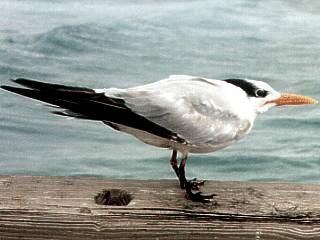
|
A type of sandpiper bird perches on the wooden railing of a fishing pier in Deerfield Beach, Florida. The bird here is facing a stiff northeast wind and didn't mind having its picture taken even when I was only three feet away. The pointed bill allows the bird to feed on crabs and other sealife hidden in rocks, wood, and sand. The legs of this bird are also well adapted for walking and running across the sand. |
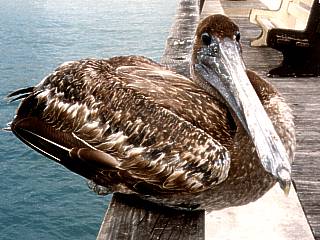
|
A pelican perches on the wooden railing of a fishing pier in Pompano Beach, Florida. These large birds are very common in tropical and subtropical marine regions and can swim in water with webbed feet just like ducks. The extra long bill has a scooping pouch for catching fish near the waters surface. The pelican here is very accustomed to people and didn't mind having its picture taken even when I was only three feet away. |
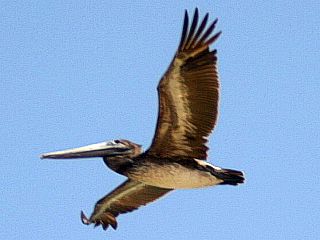
|
Here is a pelican in flight over the beach in Fort Lauderdale, Florida. These birds are large but light enough and with a large wing span to actually glide. |
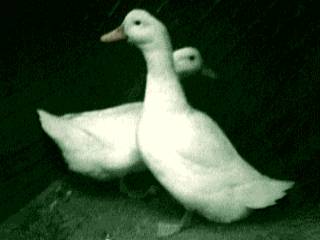
|
These are White Pekin ducks in a duck coop I built when I was living in New York. These are the most common ducks raised commercially in the United States and are commonly used for food. The ducks originally were brought into the US from China, hence the name "Pekin". The two ducks here are fully grown females and have cream colored plumage and orange bills and webbed feet. They are not very good fliers. During the summer, these ducks laid one or two large eggs every morning, about 50 percent larger than a hen's egg, and good to eat. I bought these ducks from a poultry supplier as small yellow ducklings, and raised them until they matured in about 6 months. The White Pekin duckling is much different than the adult. It is yellow and fuzzy, and about the size of a fist. Fully grown, the duck weighs about 8 pounds, with females being slightly larger than the male drakes. |
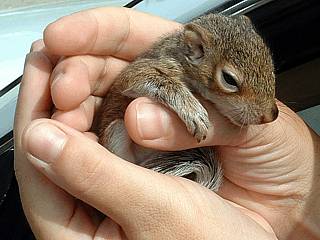
|
Here is one of two baby squirrel pups found in my storm chasing partner's front yard after hurricane Frances passed over Florida the day before in September 2004. Unfortunately, the mother squirrel was found dead a few feet away from the babies, which were given to a neighbor who raises disabled wild animals. |
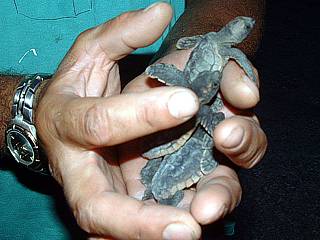
|
This is a picture of some baby sea turtles found along the roadway in Fort Pierce after hurricane Frances in September 2004. Storm surge and wave action moved these critters from the beach several miles inland during the height of the storm. Simply bringing them back to the beachfront and releasing them into the surf is all that is needed to save these animals. |
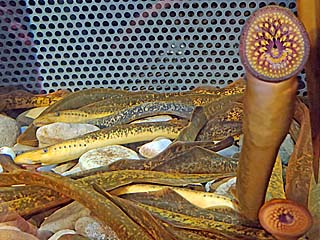
|
Here is a picture of some sea lampreys taken at the Shedd Aquarium in Chicago. These are some of the strangest eel-like creatures resembling something out of a horror movie. They are highly invasive to the Great Lakes region. The sucking mouth is rimmed with numerous teeth and attaches to native fish, boring a hole into the flesh and feeding on the bodily fluids of its host. |
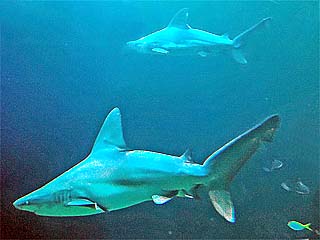
|
Sharks swimming in the reef exhibit at the Shedd Aquarium in Chicago. |
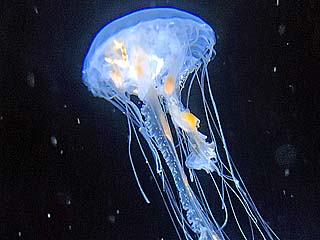
|
Beautiful jellyfish drifting in a special exhibit at the Shedd Aquarium in Chicago. |
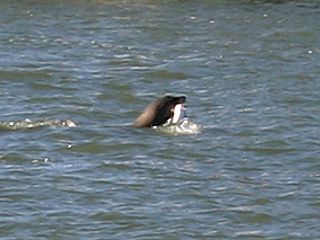
|
Here is a picture (taken from a boat) of a harbor sea lion feasting on a large fish it just caught in the San Jouquin River delta between the San Francisco bay and Sacramento. These seals are common along the US Pacific coast and are excellent swimmers, and are able to catch large fish by themselves. The fish in the sea lions mouth is most likely a makerel. |
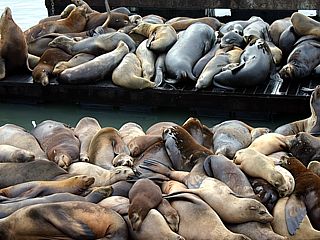
|
Numerous seals / sea lions rest on a dock in the San Francisco bay in California in November 2010. |
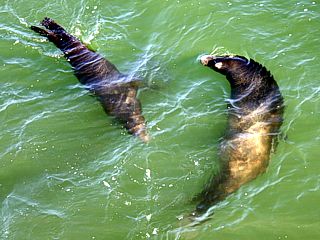
|
Here is a another picture (taken from the wharf at Santa Cruz, California) of two sea lions playfully swimming around each other in the emerald-green waters of the north Pacific Ocean. |
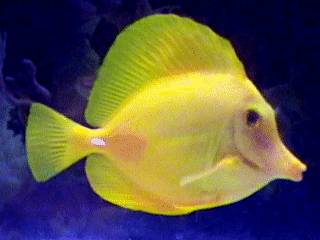
|
Taken through the glass of a 55-gallon salt water aquarium in my home, this picture shows a medium-sized yellow tang. A salt water aquarium is a big step up from a freshwater tank, and there is a lot more things you have to take care of ... The work pays off because salt water fish are far more colorful than their fresh water cousins. The yellow tang here eats mostly algae (freeze-dried seaweed) and is a common favorite in salt water tanks. |
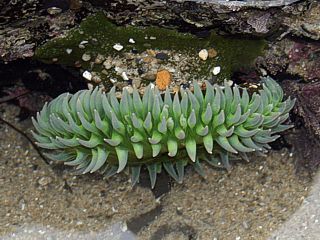
|
Here is a picture of a large sea anemone attached to the rock-bottom of a tidal pool at low tide along the coast of Northern California. These beautiful and colorful creatures use the long tentacles extended into the water to catch small fish, plankton, and other prey and pass it to its central mouth. The tentacles contain stinging cells much like those of a jellyfish and their color is actually caused by symbiotic (one helping another) algae within the organism itself. Some fish even find "homes" and protection among the tentalces. |
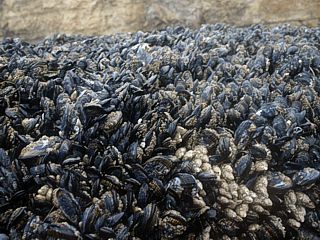
|
Thousands of mussels cling to a rock along the Northern California coast at low tide. The entire rock surface is completely covered by such shelled creatures called bivalves (two shelled) and also play an important role in cleaning the water. Coastal rocks and tidal pools are one of the most important but delicate ecosystems on earth. |
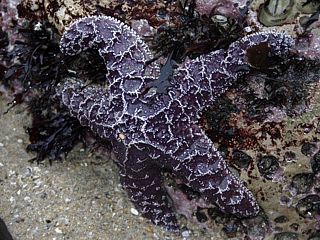
|
Here is a picture of a large purple-colored starfish attached to another rock in a tidal pool along the Northern California coast at low tide. Also, check out the many life forms on the rock itself, such as burrowing chitons, barnacles, and other shellfish. This type of rock, teaming with life, is called "live rock". |
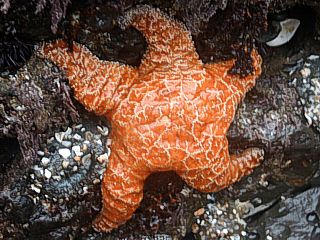
|
Here is a another picture of a large starfish attached to a tidal pool rock in Northern California. This one is colored bright orange. |
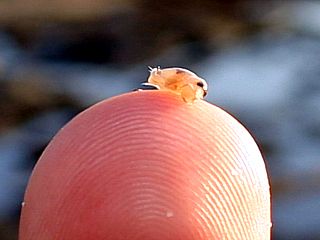
|
This is a small crustacian known as a "sand flea" which hops across the beaches of the Pacific US coast in many numbers. The correct name for this shrimp-like creature is a talitridae, and burrows into the sand on the beach. These amphipods are very small shrimps, and have black eyes, to the right in this picture. The legs / tail are to the left. These animals are slightly larger than a grain of rice. |
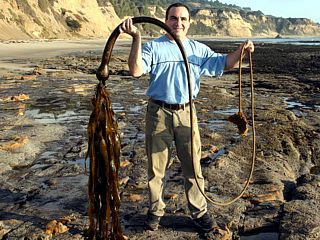
|
Not exactly an animal, but one of the most important plants that provide a marine habitat for sealife along the cold waters of the North Pacific Ocean off ther west coast of the United States. This is a picture of myself, along the coast of North-Central California, holding an entire piece of bull kelp, which is the largest of marine "algae" (or simply "seaweed"). These plants fasten themselves to the rocky ocean bottom with a "hold fast" root seen hanging down to the right. The large bulblike portion to the left is filled with gas, and serves as a float to allow sunlight to reach the leaves of the plant, also hanging down to the left from the bulb. Kelp "forests" create a diverse biological habitat for marine mammals, fish, crustacians, and many other sea creatures in this area. Bull kelp "leaves" are also edible, are a popular Asian delicacy, and can be eaten right off the plant! |
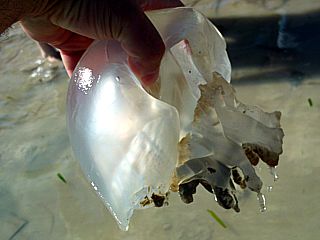
|
Here is a large jellyfish I am holding by it's non-stinging bell in the Florida Keys in March 2010. These sit at the bottom of the Florida Bay, with their tentacles facing upward, and only swim like a regular jellyfish when disturbed or migrating. The tentacles / oral arms capture small fish and crustacians and pass them to the jellyfish "mouth" after disabling them with stinging cells in the oral arms. |
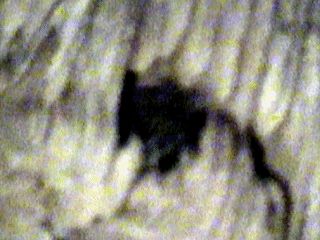
|
Deep in the entrance of Carlsbad Caverns in New Mexico, a hibernating cave bat silouette is revealed by a camera with nite vision. The bat is upside down with its wings partially opened in the typical bat formation. The cave bats remain this way until dusk, where they leave the cave as a group to search for food in total darkness. There are plenty of formations in a cave that are perfect for bats to sleep in this manner. |
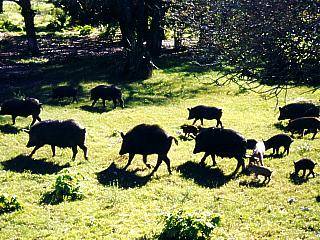
|
While on a swamp buggy tour through the Florida Everglades on the Seminole Indian Reservation in the Florida Everglades, many free roaming pigs and piglets were observed. These are not quite "wild boars", but are free roaming throughout the pastures and dry land within the federally protected confines of the reservation. The Seminole tribe has been maintaining this area since the pigs were introduced here in the turn of the 19th century. They range in size from several hundred pounds to small enough to hold in one arm. |
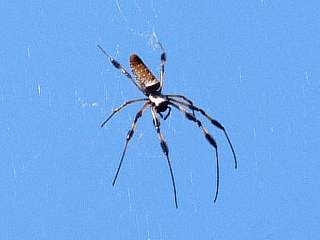
|
A large spider hangs in a large web suspended between two trees in Saint Augustine, Florida. The spider is about 2 inches across, and the blue sky provides a perfect backdrop for the specimen. Note the thin strands of the web surrounding the spider. |
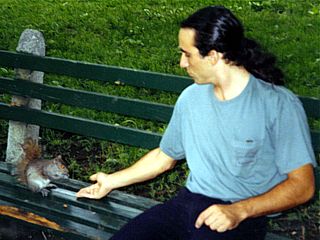
|
Here is a picture of myself feeding a brown squirrel on a park bench in Boston, Massachusetts. Normally you cannot get this close to these animals, but in this public park, they are tame enough to eat peanuts right out of your hand. |
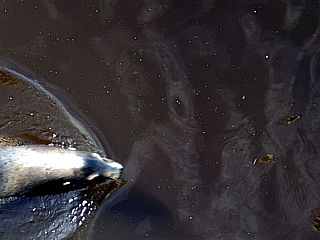
|
This is a picture of a sea lion swimming off the Wharf in Santa Cruz, California in mid November 2007. The point in this picture is not the sea lion, but the murkey brownish / red tint to the water. This is a RED TIDE that affected the area in late fall 2007. Red tide is caused by small plankton (tiny plants and / or animals) in excessive amounts and can be toxic, resulting in fish kills and beach closures. This water normally has anywhere from a blue-green to emerald green color, depending on how much "harmless" phytoplankton is present (tiny plants). Red tides are sometimes naturally occurring but can be enhanced by agricultural runoff, especially where rivers empty into the ocean. |
HTML File "animals.htm" - Developed By Chris Collura
To Return To The HOME Page Of This Site Click The "INDEX.HTM" Link Here!